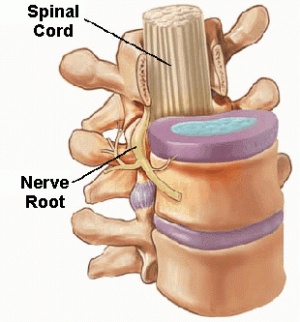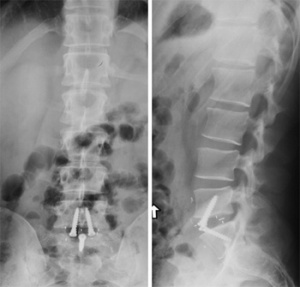
Anterior Lumbar Interbody Fusion (ALIF)
WHAT IS ANTERIOR LUMBAR INTERBODY FUSION (ALIF)?
Anterior lumbar interbody fusion (ALIF) is a type of spine surgery performed to relieve pain and other symptoms caused by a problem in the low back. Depending on the patient and their diagnosis, the surgeon may perform the operation as an open surgery or using minimally invasive instruments and techniques.


MEANING OF THE ACRONYM
ALIF means the surgery is performed from the front (Anterior) of the patient’s body—through an incision made in the patient’s abdominal region. Lumbar refers to any one of the five levels in the low back (e.g. L1-L5), also called the lumbar spine. Interbody refers to the disc between two vertebral bodies.
Anatomical spinal cord nerve root body disc anterior view. During an ALIF procedure, one or more discs (called intervertebral discs) are removed and the empty disc space is filled with an implant (e.g., interbody device, cage). Depending on the type of interbody implant, one or two devices are implanted. The implant restores and maintains adequate space between the 2 vertebrae to help prevent nerve roots from being trapped or compressed in the passageways naturally created at the left and right sides of the disc. Often screws and possibly rods/plates may be placed over or through the cages to prevent migration.
Bone graft or bone graft substitute (e.g., banked bone, various calcium-derived compounds or bone morphogenetic protein) is packed around the implant to stimulate new bone growth leading to fusion. New bone growth causes the implant to heal into and join (fuse) the vertebral bodies above and below the implant. One of the goals of fusion is to stabilize the spine.
TREATMENT
ALIF Procedure Notes
Anterior lumbar interbody fusion is performed under general anesthesia. The exposure is often performed by a vascular/general surgeon as blood vessels need to be moved out of the way for the spine surgeon to do his/her work. The size (length) of the surgical incision is dependent on whether the procedure is performed as an open or minimally invasive spine surgery (MIS).
Open spine surgery usually requires one or more long incisions.
MIS surgery requires small skin incisions that are sometimes puncture-like.
The size or number of incisions depends on the number of spinal levels to be treated (eg, single-level, multi-level).
MIS surgical techniques allows the surgeon to gently push soft tissues (eg, muscles, ligaments) aside instead of cutting to gain access to the surgical level. The minimally invasive approach may offer the patient potential advantages, such as less blood loss during surgery, decreased postoperative pain, faster healing, quicker return to activities, and minimal scarring.
The spine surgeon performs a discectomy to remove the target disc. Nerve roots are decompressed; meaning disc material or other tissues pressing on nearby nerves is removed. The empty disc space is prepared for implantation of one or two interbody devices in between the two vertebral bodies. Bone graft is packed into the disc space and around the implant(s). To help stabilize the spinal levels operated on, the surgeon may implant rods and screws (see x-rays below) sometimes called instrumentation.
SIERRA NEUROSURGERY GROUP RESOURCES
All Sierra Neurosurgery Group physicians have extensive experience performing successful lumbar laminectomies and alleviating their patients’ pain, radiating numbness, weakness and cramping.
Dr. Morgan, When I first met you, I knew I could
trust you & what you say.
My first surgery was pain free. My second surgery was pain free & corrected the pinched nerves.
Everything you told me was true. Your knowledge of medicine & your truthfulness is so refreshing. You
really care about your patients. You answered all of my questions with straight talk.
I wish I could reward you in some way.
God Bless you and your family. — John M.
